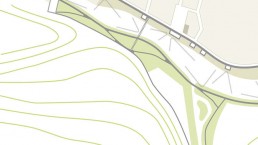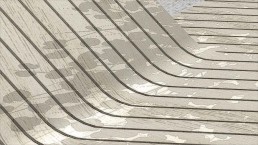BERLIN OBERSCHÖNEWEIDE CITY PLAZA - CRANEWAY PROMENADE
URBAN SQUARES
REVIEW PROCESS
BY INVITATION
1. PRIZE
IN PARTIAL
REALIZATION
The typology of architecture between Wilhelminenhofstraße and the river Spree includes industrial structures of varying dimensions as well as residential and commercial buildings. Despite this heterogeneity, area-specific open spaces can be identified: bordered corridors and squares as well as irregular expansions along the riverbank.
Referring to this open space typology, a structure of open spaces is proposed, which is assigned to the respective dominant spatial elements and support their spatial effect. The transitions between the different open spaces are emphasized by light variations in height. Thus, a spatial sequence evolves comprising the craneway promenade, the enclosure of the exhibition halls, the city square, the waterside promenade and the sculptural garden, constituting a succession of individual spaces.
As a public building, the exhibition halls receive an enclosure. Slightly elevated, it connects the craneway promenade with the city square and the waterside promenade. The slight elevation opposite of the city square accentuates the spatial opening to the water and permits an overview.
The existing crane construction emphasizes the corridor-like area of the craneway promenade. The in-situ concrete recalls the former industrial usage, enclosed by gravel.
The city plaza is situated between the exhibition halls and the proposed hotel development. The eastern side of the square is edged by a row of trees, continuing the line of trees from Laufener street across the square. Between the trees, seating groups invite to rest.
The waterside promenade is part of the projected Spree trail and connect the new Kaisersteg with the city square. It edges the slightly subjacent sculptural garden.
| Year | 05/2007 |
| Tags | Plazas, Watersides, Realizations, Competitions |




